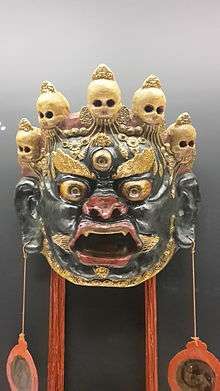Dharmapala
A dharmapāla (Wylie: chos skyong , Chinese: 達磨波羅, 達摩波羅, 護法神, 護法鬼神, 諸天鬼神, 護法龍天, 諸天善神, Japanese: 達磨波羅, 護法善神, 護法神, 諸天善神, 諸天鬼神, 諸天善神諸大眷屬[1]) is a type of wrathful god in Buddhism. The name means "Dharma protector or defender" in Sanskrit, and the dharmapālas are also known as the Defenders of the Law (Dharma), or the Protectors of the Law. There are two kinds of dharmapala, Worldly Protectors and Wisdom Protectors. Only Wisdom Protectors are enlightened beings.[2]
| Part of a series on |
| Buddhism |
|---|
 |
|
|
|
Description
A protector of Buddhist dharma is called a dharmapala. They are typically wrathful deities, depicted with terrifying iconography in the Mahayana and tantric traditions of Buddhism.[3] The wrathfulness is intended to depict their willingness to defend and guard Buddhist followers from dangers and enemies. The Aṣṭagatyaḥ (the eight kinds of nonhuman beings) is one category of dharmapālas, which includes the Garuda, Deva, Naga, Yaksha, Gandharva, Asura, Kinnara and Mahoraga.[3]
In Vajrayana iconography and thangka depictions, dharmapala are fearsome beings, often with many heads, many hands, or many feet. Dharmapala often have blue, black or red skin, and a fierce expression with protruding fangs. Although dharmapala have a terrifying appearance, they only act in a wrathful way for the benefit of sentient beings.
The devotional worship of dharmapālas in the Tibetan tradition is traceable to early 8th-century.[3]
Tibetan Buddhism
There are many different dharmapalas in Tibetan Buddhism. Each school has its own principle dharmapalas and most monasteries have a dedicated dharmapāla which was originally comparable to a genius loci. The many forms of Mahakala are emanations of Avalokiteshvara. Kalarupa and Yamantaka are considered by practitioners to be emanations of Manjushri the Bodhisattva of Wisdom.
Principal wisdom protector dharmapalas include:
- Prana Atma (Tib. Begtse)
- Ekajaṭī (Tib. ral chig ma)
- Mahakala (Tib. Nagpo Chenpo)
- Shri Devi (Tib. Palden Lhamo)
- Yama (Tib. Shinje)
Other dharmapalas include:
- Citipati
- Mahakali
- Yamantaka (Tib. Shinje Shed)
- Hayagriva (Tib. Tamdrin)
- Vaisravana (Tib. Kubera)
- Rāhula (Tib. gza)
- Vajrasādhu (Tib. Dorje Legpa)
- Brahma (Tib. "Tshangs Pa")
- Maharakta (Tib. tsog gi dag po, mar chen)
- Kurukulla (Tib. rig che ma)
- Vajrayaksa (Takkiraja) (Tib. du pai gyal po)
The main functions of a dharmapāla are said to be to avert the inner and outer obstacles that prevent spiritual practitioners from attaining spiritual realizations, as well as to foster the necessary conditions for their practice.[4]
Shingon Buddhism
In Japanese Shingon Buddhism, a descendant of Tangmi, or Chinese Esoteric Buddhism, dharmapālas such as Acala and Yamantaka are classified as Wisdom Kings. Other dharmapālas, notably Mahakala, belong to the Deva realm, the fourth and lowest class in the hierarchy of honorable beings.
Related deities
In Tibetan Buddhism, there are two other classes of defender, the lokapālas and kṣetrapalas. Papiya,[5] Guan Yu and Hachiman are also known as defenders.
See also
References
- 「梵天帝釋二大天王 日本國中大小神祇 諸天善神 諸大眷屬」(般若心經奉讚文)
- https://www.himalayanart.org/search/set.cfm?setID=2404 Buddhist Protectors, Wisdom Deities: Dharmapalas at Himalayan Art Resource
- Robert E. Buswell Jr.; Donald S. Lopez Jr. (2013). The Princeton Dictionary of Buddhism. Princeton University Press. pp. 249–250. ISBN 978-1-4008-4805-8.
- Heart Jewel: The Essential Practices of Kadampa Buddhism, pages 71-3, Tharpa Publications (2nd. ed., 1997) ISBN 978-0-948006-56-2
- 曼荼羅 GIALABA
Bibliography
- Kalsang, Ladrang (1996). The Guardian Deities of Tibet Delhi: Winsome Books. (Third Reprint 2003) ISBN 81-88043-04-4.
- Linrothe, Rob (1999). Ruthless Compassion: Wrathful Deities in Early Indo-Tibetan Esoteric Buddhist Art London: Serindia Publications. ISBN 0-906026-51-2.
- De Nebesky-Wojkowitz, Rene (1956). Oracles and Demons of Tibet. Oxford University Press. Reprint Delhi: Books Faith, 1996 - ISBN 81-7303-039-1. Reprint Delhi: Paljor Publications, 2002 - ISBN 81-86230-12-2.
External links
| Wikimedia Commons has media related to Dharmapala. |
- Buddhist Protectors - outline page at Himalayan Art Resources
- Citipati Buddhist Protector - Citipati Ritual Mask
